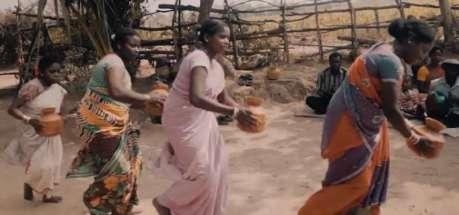
4 minute read
2.4 Cultural Relevance
Scheduled Tribe (ST) in 2004, by the Government of Karnataka.Dance and music are integral to their cultural identity. They are widely known for their expressive dance form Siddi Dhamal, which portrays their community life. Dhamal was originally performed as a celebratory dance, when members of the community returned from a successful hunt. Today, the Siddis dance on any occasion — they also sing and dance to cheer themselves up following the death of a community member. While women sing a repetitive song pattern, the men usually play the dammam — a percussive instrument which looks similar to a mridangam, but is made of wood and deerskin on the sides — and set the rhythm. While a singer leads with a phrase, others repeat in unison, in a refrain-like manner.
Women performing the Dhamal dance after a meal A siddi man playing the percussive drum.
Advertisement
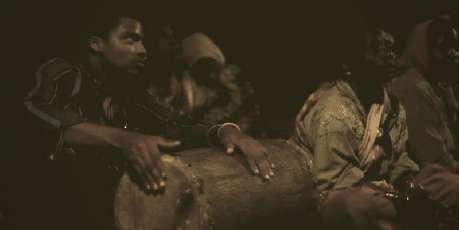
The dancers are colourfully dressed and adorned with leaves, with their faces painted. The language is predominantly Kannada, and though they are influenced by the Indian culture and language, their ancestral dress code still retains it’s unique identity.The Siddis live in tune with Nature and depend on it for survival. And so, their music and dance are inspired by anything that happens around them.
A few years back in the year of 2004, a news article about an interview with the Siddi’s surfaced, it read ‘At Elliotsbeach, they perform a song called ‘Fish’, which narrates how the elders from their community cook fish, while the younger ones ask how they are harming the ecosystem. “We sing about fishing, how ants eat and anything that is around us. Nature is our only inspiration,” says Lily, before she and her group break into a a song called ‘Chicken Saadam.’ It talks of how the Siddis can hunt down a chicken easily, but are often not able to buy rice to eat with it. Having lived in India for more than 400 years, are they curious about their roots? Lily says that her friends recently visited their ancestral town in Africa and the results were very different from their expectations. “They found that the language they speak is different and the community had a different lifestyle,” says Lily. She explainsthat though many of them are curious about their origins, they have mixed feelings about returning to Africa for good.She says, “What if things have changed completely and they don’t accept us?”
Today, about 50,000 Siddi people live all over India, of which, more than a third live in the northern parts of Karnataka. They speak their own language called Siddi Basha, and having lived in Karnataka for generations, they are also fluent in Kannada.
PERFORMING ARTS ( TRIBAL RELATED AND SPORTS) :
The onefactor which binds the Siddhis, irrespective of their religion is the Hiriyaruor ancestor worship. The dead are believed to be nearby, in the form of spirits. They are regarded as witnesses to be consulted by a family in all its concerns. On occasions like births, marriages and deaths, the ancestors are invoked. The home is organised around Hiriyaru, the spirits of departed parents. It signifies a remembrance of the parents, thanking them for their care over several years and also entreating them to keep a vigil over the family in future. It is obligatory for all relatives to attend the function, thus renewing kinship relations.

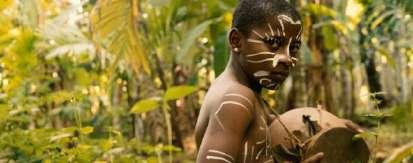
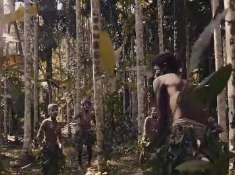
Tribal initiation ceremonies of a boy becoming a man with challenges of strength and will are conducted in the tribe.
Hiriyaru worship may be performed twice a year by the 'Kartha'(head) of the family. It normally is held during the Navarathri festival in the first week of November. If this is not possible for some reason, it may also be performed in April–May during the other major festival - Holi. These obviously are not meant to coincide with the dates of the parents' deaths as the Siddis only observe the first death anniversary. Hindu Siddhis usually have elaborate functions to mark the event, but not so the Christian and Muslim Siddhis.
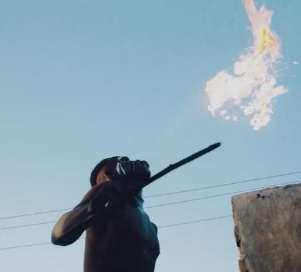

Tribal Ceremony rituals
In 1987, the Sports Authority of India (SAI), spearheaded by the then Union Minister of Youth Affairs and Sport Margaret Alva, began initial efforts to set up a sports scheme to scout and train members of the community in hopes of tapping into yet undiscovered athletic abilities of the Siddi people.Around 65 athletes were chosen to be trained in various athletic events. They were even taken to Bengaluru for training after an initial period of training in their schools. However, the ‘Special Area Games Scheme’ was discontinued six years later in 1993 leaving members of the community who enrolled for the programme stranded. “The scheme was not planned well. The community has been isolated for so long. So a scheme like this is essentially an integration into mainstream society and not just a sports training scheme. You actually needed mentors, people who would be able to mentor the Siddis and integrate them. This was not well thought out and that is why they started and stopped, and the scheme never came to fruition.”
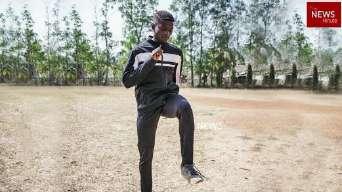
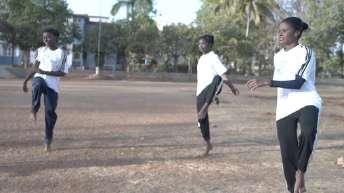
Siddi Student athletes practicing for sports under the government scheme.










